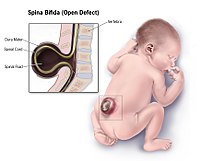
Global Policy and Practice for Intrauterine Fetal Resuscitation During Fetal Surgery for Open Spina Bifida Repair
Sign Up to like & getrecommendations! Published in 2023 at "JAMA Network Open"
DOI: 10.1001/jamanetworkopen.2023.9855
Abstract: Key Points Question What is current global practice for fetal resuscitation, emergency delivery, and subsequent neonatal resuscitation during fetal surgery for open spina bifida repair? Findings This global survey study of 28 centers in 11… read more here.
Keywords: fetal resuscitation; open spina; spina bifida; fetal surgery ... See more keywords

Understanding how the concentration of neighborhood advantage and disadvantage affects spina bifida risk among births to non‐Hispanic white and Hispanic women, Texas, 1999–2014
Sign Up to like & getrecommendations! Published in 2018 at "Birth Defects Research"
DOI: 10.1002/bdr2.1374
Abstract: This is the first study to utilize the index of concentration at the extremes (ICE) to examine risk factors for spina bifida in Texas. The ICE is a useful measure for providing the degree to… read more here.
Keywords: risk; concentration neighborhood; understanding concentration; neighborhood advantage ... See more keywords

The National Spina Bifida Patient Registry: A Decade's journey
Sign Up to like & getrecommendations! Published in 2018 at "Birth Defects Research"
DOI: 10.1002/bdr2.1407
Abstract: The National Spina Bifida Patient Registry (NSBPR) was established in 2008, as a partnership between the CDC and spina bifida (SB) clinics throughout the United States. The purpose of this study is to explore the… read more here.
Keywords: patient registry; national spina; spina; spina bifida ... See more keywords

Association of interpregnancy change in body mass index and spina bifida.
Sign Up to like & getrecommendations! Published in 2019 at "Birth defects research"
DOI: 10.1002/bdr2.1547
Abstract: BACKGROUND Epidemiologic studies have consistently identified an association between spina bifida and maternal body mass index (BMI). Whether this reflects a causal relationship is unknown. If this association does reflect a causal relationship, the risk… read more here.
Keywords: body mass; change; bmi; association ... See more keywords

Association between maternal pregestational diabetes mellitus and spina bifida: A population-based case-control study, Finland, 2000-2014.
Sign Up to like & getrecommendations! Published in 2019 at "Birth defects research"
DOI: 10.1002/bdr2.1624
Abstract: BACKGROUND Maternal pregestational diabetes mellitus (PGDM) is a known risk factor for neural tube defects. We examined the association between maternal PGDM and spina bifida in the offspring using PGDM status from medical records in… read more here.
Keywords: bifida; pgdm; association; case control ... See more keywords

Characteristics and first‐year mortality, by lesion level, among infants with spina bifida in the New York State Birth Defects Registry, 2008–2017
Sign Up to like & getrecommendations! Published in 2021 at "Birth Defects Research"
DOI: 10.1002/bdr2.1978
Abstract: Spina bifida is the most common neural tube defect. It has been associated with increased mortality, disability, and may require lifelong medical care. Higher‐level lesions have been shown to be associated with increased mortality in… read more here.
Keywords: spina bifida; infants spina; level; mortality ... See more keywords

Loss of RAD9B impairs early neural development and contributes to the risk for human spina bifida
Sign Up to like & getrecommendations! Published in 2020 at "Human Mutation"
DOI: 10.1002/humu.23969
Abstract: DNA damage response (DDR) genes orchestrating the network of DNA repair, cell cycle control, are essential for the rapid proliferation of neural progenitor cells. To date, the potential association between specific DDR genes and the… read more here.
Keywords: rad9b; loss rad9b; neural development; risk human ... See more keywords

Assessment of lower limb trophism in fetuses with open spina bifida using fractional thigh volume of three‐dimensional ultrasound
Sign Up to like & getrecommendations! Published in 2022 at "Journal of Clinical Ultrasound"
DOI: 10.1002/jcu.23364
Abstract: To assess the trophism of the lower limbs of fetuses with open spina bifida using fractional thigh volume (TVOL) of three‐dimensional (3D) ultrasound. read more here.
Keywords: spina bifida; open spina; fetuses open; using fractional ... See more keywords

Fecal incontinence in patients with spina bifida: The target is the rectum
Sign Up to like & getrecommendations! Published in 2018 at "Neurourology and Urodynamics"
DOI: 10.1002/nau.23417
Abstract: The prevalence rate of severe fecal incontinence (FI) in adults with spina bifida (SB) is high. The physiological basis of FI in SB has not been clearly established, which contributes to inadequate care. The aim… read more here.
Keywords: fecal incontinence; incontinence patients; patients spina; spina bifida ... See more keywords

Are EAU/ESPU pediatric urology guideline recommendations on neurogenic bladder well received by the patients? Results of a survey on awareness in spina bifida patients and caregivers
Sign Up to like & getrecommendations! Published in 2019 at "Neurourology and Urodynamics"
DOI: 10.1002/nau.24024
Abstract: The Paediatric Urology Guidelines Panel reports initial experience with patient involvement in spina bifida patient groups to gather information on their awareness of the guidelines and reflection of guideline recommendations. read more here.
Keywords: guideline recommendations; spina bifida; urology;

Long‐term effectiveness and safety of bladder augmentation in spina bifida patients
Sign Up to like & getrecommendations! Published in 2021 at "Neurourology and Urodynamics"
DOI: 10.1002/nau.24713
Abstract: To establish the long‐term efficacy and safety of bladder augmentation in spina bifida patients. read more here.
Keywords: bladder augmentation; long term; augmentation spina; bifida patients ... See more keywords